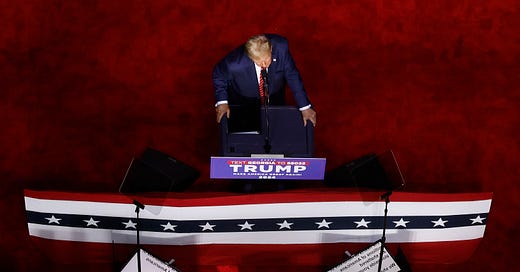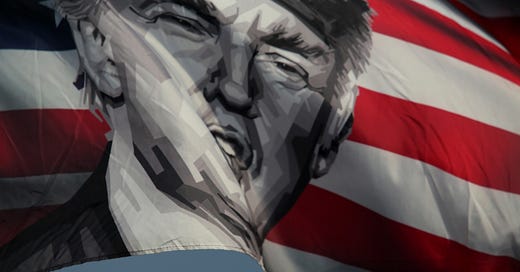
Trump Meets Three of the Four Criteria for Fascism
A second term could bring the fourth within his reach.
The Wannabe Fascists
A Guide to Understanding the
Greatest Threat to Democracy
by Federico Finchelstein
California, 250 pp., $24.95
IN THE INITIAL, HEADY DAYS after Joe Biden’s 2020 victory over Donald Trump, many public commentators played down Trump’s threats of not leaving the White House quietly, with some outright dismissing concerns about his electoral lies.
Others, though, saw Trump for exactly who he was—and his actions for exactly what they were, even from the outset. One of those discerning voices was Federico Finchelstein, a professor at the New School who studies the history and dissemination of fascism. Just a few days into Trump’s refusal to concede, Finchelstein authored an op-ed in the Washington Post linking Trump directly to a series of previous authoritarians who clung to power, helping introduce Americans to the term auto-golpe (self-coup). It was one of the most prescient pieces of analysis of America’s post-election troubles—vindicated especially on January 6th, when Trump helped sic insurrectionists set on violently overturning the election results.
Now, Finchelstein has a new book out on the topic, focusing on what makes Trump, and the other budding autocrats rising alongside him, so dangerous. In so doing, Finchelstein hopes to cut through some of the definitional clutter of what Trump was, and still is. Trump is not, as his supporters would have him, simply a populist. But given his failures on January 6th and afterward to cling to power, he’s also not a classic fascist, at least as popularly understood. He is, rather, something else—something can be found in the title of Finchelstein’s book: The Wannabe Fascists.
These definitional elements may seem trite. (What difference does it make to a woman imprisoned for abortion, or an immigrant family forced apart by Trump’s policies, whether it’s accurate to call him a fascist?) But as Finchelstein ably argues, it’s only in properly defining Trump—and properly understanding his historical context, American and otherwise—that we can truly understand the threat he poses and navigate the world he’s ushered in.
Indeed, much of the book is devoted to definitions, and to identifying where the lines between populism and fascism truly lie. And understandably so; ever since Trump first rose to political prominence in 2015, opponents have wondered aloud about whether he’s a fascist.
But Finchelstein isn’t so quick to apply the label to Trump, even nearly a decade later. Fascism, for Finchelstein, is “a global ideology with separate national movements and regimes,” an ideology whose “primary aim” is “to destroy democracy from within in order to create a modern dictatorship from above.” Implementing a “divine, messianic, and charismatic form of leadership that conceived of the leader as organically linked to the people and the nation,” fascism broadly “aimed to create a new and epochal world order through . . . extreme political violence and war.” With four primary characteristics—political violence, propaganda, xenophobia, and ultimate dictatorship—fascism took root around the world throughout the twentieth century, beyond just places like Mussolini’s Rome or Hitler’s Berlin.
Running through such a definition, elements of Trumpism—as well as the records of similar rulers elsewhere, such Brazil’s Jair Bolsonaro and Hungary’s Viktor Orbán—clearly shine through, not least as it pertains to the Christian nationalists who perceive Trump as a source of divine retribution against perceived enemies. Yet, Finchelstein argues, Trump has thus far fallen short of checking all of the boxes of traditional fascism. While he has clearly built out planks of political violence (not least how he’s transformed January 6th insurrectionists into supposed martyrs), propaganda, and xenophobia, he has been unable to construct a full dictatorship. In that sense—and, again, in a similar vein to Bolsonaro, Orbán, or even increasingly leaders like India’s Narendra Modi or El Salvador’s Nayib Bukele—Trump is simply an aspiring fascist, rather than a fully realized one. He is, as Finchelstein writes, a “populist aspirant to fascism”—or, again, a “wannabe fascist.”
In a certain sense, this is almost a distinction without a difference—and is hardly far off from what other books and authors have argued. (It’s not a surprise to learn that Trump would lead a dictatorship, if only he could.) But it is Finchelstein’s parallel definitions—that is, of outlining what makes one a populist, rather than a fascist outright—that sets The Wannabe Fascists apart from the mountains of previous Trump-related analysis. Finchelstein’s efforts at tracing the arcs and outlines of not just fascism but also populism present the book’s most successful intervention.
FINCHELSTEIN PLACES THE ROOTS of populism at the end of the Second World War. From the rubble of crumbled fascist regimes sprang the first shoots of modern populism—a form of illiberal democracy, reliant on elections and yet aimed at stripping “political minorities” of basic rights, all while “bolster[ing] social and political polarization” across the country. Populists, Finchelstein writes, achieve democratic legitimacy through free (if not entirely fair) elections—and then use such legitimacy as a way to implement “highly hierarchical leadership.” “Populism, in short, is an authoritarian form of democracy,” he says.
Finchelstein’s chronology is compelling, placing the rise of modern populism within those Cold War-era regimes that were looking for a “third way” between unfettered capitalism and Soviet-sponsored communism. But it’s not when he places it, but where he places it, that provides the book’s most worthwhile additions to the conversations about Trump and fascism. That is, Finchelstein traces traditional populism to South America in particular, a region that helped provide the caudillo-esque blueprint Trump has attempted to follow—and a region whose myriad histories Americans are still woefully unfamiliar with.
For Finchelstein, the ur-populist is Juan Perón, the longstanding strongman of Argentina. While Finchelstein—who was born in and grew up in Argentina—acknowledges Perón’s role in the country’s WWII-era military junta and as a figure who later “welcomed many Nazis and other fascists” to Argentina after the war, he argues that Perón’s leadership never veered into fascism outright. For instance, Perón “clearly rejected” the notion of political violence. Moreover, Perón “encouraged and participated” in democratic elections, helping to unwind the country’s previous regime. As Finchelstein writes, Perón “understood that elections provided a critical source of political legitimacy.” Perónism “was the first movement that attempted to adapt the legacy of fascism to a novel democratic framework.” In so doing, it “became the first example of a modern populist regime.”
But Perón was hardly alone. Leaders like Getúlio Vargas in Brazil, Rómulo Betancourt in Venezuela, and Víctor Paz Estenssoro in Bolivia—populists all—“created a new form of political regime that combined democracy with illiberalism.” Across the continent, populist regimes swore off political violence, while nonetheless consolidating power among themselves and allies—eroding democracy (and staving off communism), without ever implementing the kinds of one-party states or despotic regimes rising elsewhere. While the governments’ rhetoric was hardly inspiring—at one point, Perón claimed that the “world is divided into two tendencies: the People and the anti-people,” whatever that meant—they were still regularly tested at the ballot box, and even, as with Trump, voted out.
THE WANNABE FASCISTS IS HARDLY an exhaustive examination of such South American populism. But it is—and this is perhaps the true strength of the book itself—a reminder that Americans’ mental models for modern populism, and even fascism itself, all too often come with a Eurocentric bent. Instead of having conversations about populism and fascism centered solely on Hitler’s Germany or Mussolini’s Italy, Finchelstein successfully refocuses them through a far more American lens (in the sense of arising from the Western Hemisphere). Finchelstein also recenters fascism through a far more American lens (in the sense of the United States of America) by pointing to groups like the Ku Klux Klan as the kinds of proto-fascist militias that would later inspire fascists elsewhere.
This is perhaps why Finchelstein, unlike many others, immediately recognized Trump’s lack of concession following the 2020 election for what it was. With a far deeper familiarity with the Western Hemisphere’s history of populism, he could more nimbly recognize potential fascism in the offing—and how Trump-like figures had lurched from traditional populism toward would-be fascism.
And it is South America that is home to the auto-golpe, that swerve from populism to dictatorship. Whether under Juan María Bordaberry in Uruguay, Alberto Fujimori in Peru, or Nicolás Maduro in Venezuela, ensconced populists, realizing their reigns were set to end, used their powers of office to smother democracy once and for all in their home countries. All of which, of course, Trump attempted to do in the aftermath of the 2020 election.
And all of which he would try to do again upon a return to office.
Finchelstein’s book isn’t without flaws; at fewer than 200 pages, it elides plenty of elements and examples of fascism. Most glaringly, there’s hardly any treatment of one of the most pressing questions relating to the definition of modern fascism: whether Vladimir Putin’s regime in Russia qualifies as fascist, let alone what the policy implications of such a reality would be. Putin’s Russia is, after all, a dictatorial regime built upon historic grievances, dedicated to revanchist imperialism, all led by a man convinced of his own messianism—and one, in that sense, that mirrors Hitler’s model far more closely than Trump ever has.
But maybe that’s a conversation for another book. Because right now, with a U.S. election less than six months away, the American wannabe despot is eager to take power once more in Washington—this time without any need for a self-coup. It’s for Americans themselves to decide whether they’d like to offer Trump the opportunity, as a would-be fascist, to finally get what he wants.


















